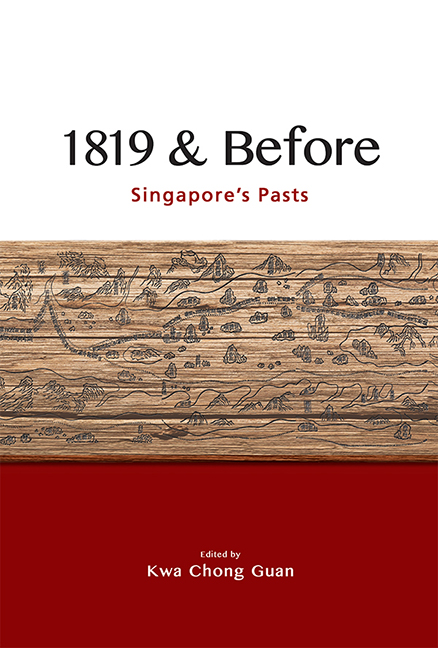Book contents
- Frontmatter
- Contents
- Foreword
- Acknowledgments
- Contributors
- 1 Introduction: Approaches to Singapore’s Past before 1819
- 2 Issues and Approaches to Studying Singapore before 1819
- 3 Regional Influences, International Geopolitics and Environmental Factors in the Rise and Demise of Temasek
- 4 The Mysterious Malay Jong and Other Temasek Shipping
- 5 The Orang Laut and the Negara Selat (Realm of the Straits)
- 6 Avoidance of Shipwreck in the Malay Annals: A Trope in Buddhist Narratives of Maritime Crossings
- 7 The Inception of Lion City
- 8 A Note on Amoghapāśa-Lokeśvara in Singapura
- 9 Portuguese and Dutch Records for Singapore before 1819: An Overview
- 10 Zheng He’s Navigation Methods and His Visit to Longyamen, Singapore
- Bibliography
- Index
7 - The Inception of Lion City
Published online by Cambridge University Press: 09 October 2021
- Frontmatter
- Contents
- Foreword
- Acknowledgments
- Contributors
- 1 Introduction: Approaches to Singapore’s Past before 1819
- 2 Issues and Approaches to Studying Singapore before 1819
- 3 Regional Influences, International Geopolitics and Environmental Factors in the Rise and Demise of Temasek
- 4 The Mysterious Malay Jong and Other Temasek Shipping
- 5 The Orang Laut and the Negara Selat (Realm of the Straits)
- 6 Avoidance of Shipwreck in the Malay Annals: A Trope in Buddhist Narratives of Maritime Crossings
- 7 The Inception of Lion City
- 8 A Note on Amoghapāśa-Lokeśvara in Singapura
- 9 Portuguese and Dutch Records for Singapore before 1819: An Overview
- 10 Zheng He’s Navigation Methods and His Visit to Longyamen, Singapore
- Bibliography
- Index
Summary
In order to understand the nature of a city, it is necessary to understand its founding moment, according to classicists. The traditional account of the founding of pre-colonial Singapura is famously related in the Sejarah Melayuliterature. Prince Sang Nila Utama sailed to the coast of Temasek, glimpsed a powerful beast there—likened to a lion by bystanders—and was inspired to build “Lion City”. Two points will be made here regarding the significance of this often misunderstood episode. Firstly, the city was founded at a place and time that show it to have intruded on a community existing nearby. Secondly, the city's rulers justified their legitimacy by drawing on the South Asian trope of an animal that reveals a charmed place for a settlement.
Temasek's Geographic and Temporal Extent
The traditional account of Singapore's founding leaves out an important part of the picture: people were already living on the island. It is well known that Singapura was founded in a place called Temasek, but here it will be argued that Temasek had its own pre-existing settlement, which was not much older than the new city. What does Temasek include, and when and why did it become known by that name?
There is no record of Temasek before the year 1225, when Zhao Rukuo wrote about a place called Lengga Entrance 凌牙门 (foreign terms transcribed on voyages from Fujian are conveyed here in Hokkien pronunciation). This trading post is usually identified with the Lengga Entrance 龙牙门, Longyamen, documented in 1350 in Wang Dayuan's Description of the Barbarians of the Isles. Wang's statement that this place is occupied by natives of Temasek (Tanmasek 单马锡) allows it to be recognized as the western entrance of Telok Blangah, present-day Keppel Harbour. The entrance was once marked by a tall sea stack, resembling a lingga, which is presumably the basis for the name Lengga. This is the place where Sang Nila Utama came ashore, according to tradition, after losing his crown on the sea journey from Batam. According to Zhao, it would have been a thriving shipping lane for decades before Sang Nila Utama arrived in the 1290s. But this is not where the prince has his fateful animal encounter and builds a city. That takes place at Kuala Temasek and the Padang, the present-day Fort Canning and Civic District area, a good distance from Telok Blangah (fig. 7.1).
- Type
- Chapter
- Information
- 1819 & BeforeSingapore's Pasts, pp. 65 - 76Publisher: ISEAS–Yusof Ishak InstitutePrint publication year: 2021

